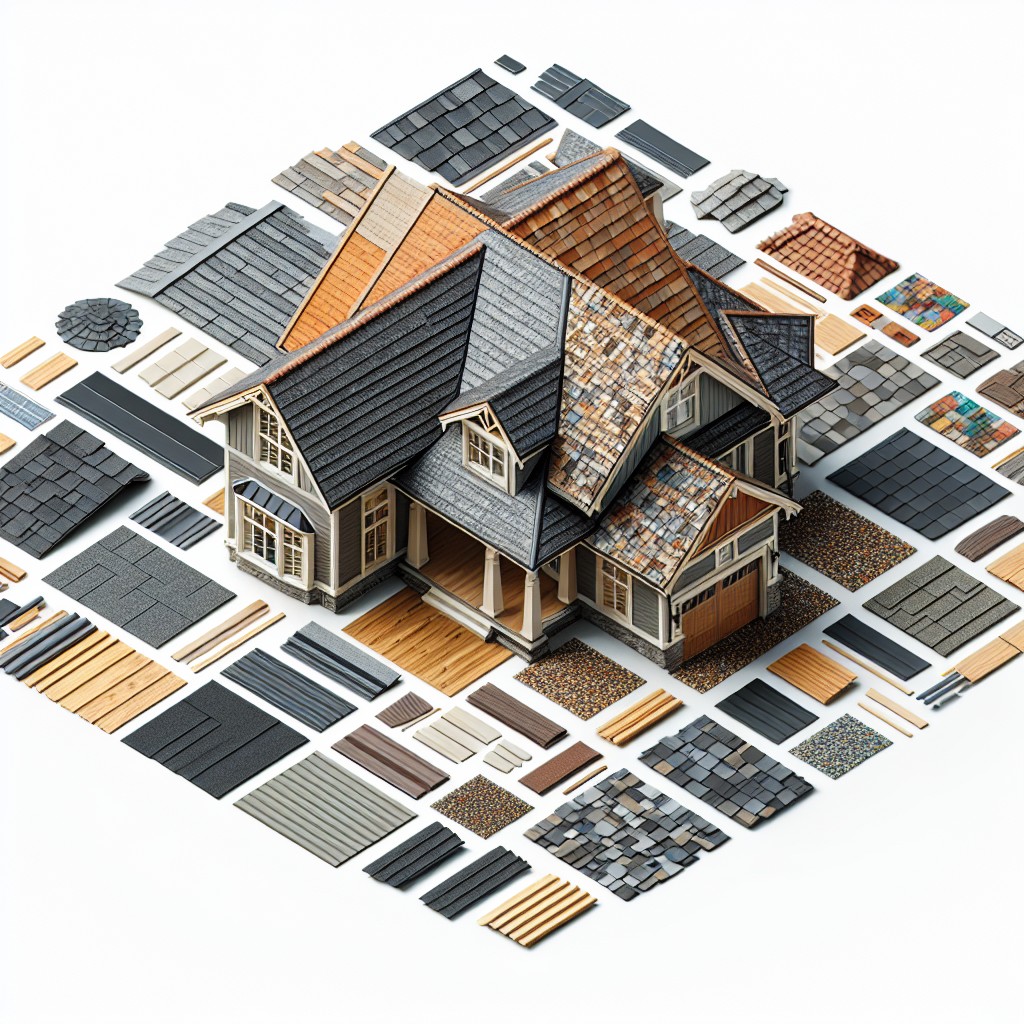Last updated on
Pricing a new roof for a typical house could spark a range of figures because multiple factors play part in final cost estimates, making it essential to understand these variables.
Key takeaways:
- Roof material: Prices range from .50 to per square foot.
- Roof size: A 2,200 square foot house may have a roof of approximately 3,300 square feet.
- Labor costs: Labor accounts for 60% of the total roofing price.
- Your location: Costs can vary based on the local cost of living and weather conditions.
- Removal of current roof: Prices range from 0 to 0 per square.
Roof Material

When considering replacement costs, the choice of roofing material significantly influences the overall expense. Asphalt shingles, well-regarded for their cost-effectiveness and ease of installation, are the most economical, averaging $3.50 to $5.50 per square foot. Architectural shingles, a thicker and more durable variant, can increase the cost to about $5 to $10 per square foot.
Metal roofs offer longevity and energy efficiency, with prices ranging from $5 to $14 per square foot, depending on the type of metal. Those opting for the natural elegance of wood shingles must budget for $6.50 to $15 per square foot, while wood shakes are slightly higher.
For a premium finish, tile roofs evoke timeless beauty but require a steeper investment at $7 to $20 per square foot, factoring in the heavy material and specialized installation. Slate roofing tops the scale for both luxury and price, with costs soaring to $15 to $30 per square foot.
Composite materials present an attractive middle ground, both in price and performance, often landing between the cost of asphalt shingles and premium materials like slate.
Remember, material costs are highly variable, influenced by brand, quality, and regional market trends, so these figures can fluctuate. It’s crucial to get the most recent prices from suppliers or contractors to budget accurately for your roofing project.
Roof Size

The square footage of your home’s roof is often different from the square footage of the house itself due to the pitch, or slope, of the roof. Typically, roofs have more surface area than the base of the house to accommodate this slope. For a 2,200 square foot house, the roof can vary in size; however, a rough estimate for a roof’s square footage is often 1.5 times the area of the house’s floor plan, leading to an approximate roof area of 3,300 square feet.
When estimating the cost for a roof replacement, contractors use ‘squares’. A square represents a 10-foot by 10-foot area, or 100 square feet. The size of the roof directly impacts the amount of materials needed and the labor involved, with larger roofs requiring more of both. In the case of a 3,300 square foot roof, you’d be looking at about 33 squares.
Understanding the size of your roof is critical for getting an accurate cost estimate for a replacement. The larger the roof, the higher the cost will be, due primarily to the increased amount of materials and the labor to install them. Keep in mind, the complexity of the roof design might also influence the total cost. More intricate designs with multiple valleys and peaks can increase the roof’s overall square footage and complexity, leading to additional labor costs.
Labor Costs
Labor costs for roofing can vary widely based on several factors such as the complexity of the job, the type of materials used, and the experience level of the workers. Typically, labor accounts for 60% of the total roofing price.
Complexity: A roof with multiple skylights, chimneys, and steep slopes will require more time and expertise, resulting in higher labor costs.
Type of Material: Labor for installing slate tiles is more expensive than for basic asphalt shingles due to the additional skill and time required.
Experience: More seasoned professionals often charge more for their expertise but can provide higher quality work and efficiency.
Regional Differences: Labor costs can fluctuate depending on the local cost of living and the availability of roofing contractors in the area.
Factor in that most contractors charge per roofing square (100 square feet). It’s crucial to obtain multiple estimates to ensure competitive pricing and find the best value for your specific roofing project.
Your Location
Regional factors significantly affect roof replacement costs. In urban areas where the cost of living is higher, you can expect to pay more for labor and materials compared to rural areas.
If your location experiences extreme weather conditions like heavy snowfall, strong winds, or hurricanes, roofing materials need to meet specific building codes, which may increase the overall cost.
Additionally, accessibility and the local market competition among contractors can impact the final price. Transporting materials to remote locations might also incur extra charges.
Always consider the specifics of your region when budgeting for your roof replacement to get a more accurate estimate.
Removal of Current Roof
The cost of removing an existing roof can vary depending on several factors, such as the number of layers to be stripped, the materials used, and the accessibility of the roof. Typically, contractors charge by the square (a 100-square-foot area), with prices ranging from $100 to $150 per square. Certain materials like metal and tile could increase removal costs due to their weight and difficulty to dismantle.
Additionally, if your old roof has extensive damage, it could require more labor to remove, which would increase the cost. It’s important to include removal fees when estimating the total cost of your roof replacement project.
Roof Sheathing Repair
Upon removing the old roofing material, the underlying wood deck, or sheathing, needs thorough inspection for damage. This step is vital as sheathing serves as the base for your new roof.
- Water Damage: Look for signs of water damage such as rot or mold. These indicate leaks that have compromised the integrity of the wood.
- Sagging Boards: If you observe any sagging or the wood feels soft to the touch, it’s a clear sign the sheathing is weak and requires replacement.
- Holes and Gaps: Examine for any gaps or large holes that could affect the roof’s structure and allow for pests or water to penetrate.
- Code Compliance: Ensure that any replaced sheathing complies with current building codes which may have changed since the original roof was installed.
- Material Choice: When replacing, consider materials like plywood or OSB (oriented strand board), which are common for sheathing, depending on your budget and the desired durability.
It’s crucial to address these issues promptly to create a solid base for your new roof and to prevent future complications. Remember, effective sheathing repair can significantly extend the life of your roof and offer peace of mind about the protection of your home.
Choosing a Roofing Contractor
Selecting the right contractor is vital to ensuring a hassle-free roof replacement. Verify credentials by ensuring they’re licensed, insured, and carry worker’s compensation.
Look for a solid reputation by reading reviews and asking for references. Don’t just compare quotes; evaluate the detail and transparency of each proposal.
Ask about the crew’s experience to confirm they have the expertise to handle your project. Inquire about project management – who will oversee the job and how communication will be handled.
Ensure they provide a clear warranty for both materials and labor. Always obtain a written contract, detailing every aspect of the work to be done.
Paying For a New Roof
Understanding the financial aspect of roof replacement is crucial for homeowners. There are several methods to fund this significant investment:
- Savings: Utilizing personal savings is the most straightforward method to pay, avoiding interest charges.
- Home Equity Loans: These loans may offer favorable interest rates and tax deductions for homeowners with sufficient equity.
- Financing through Contractors: Some roofing companies provide financing options; carefully review the interest rates and terms.
- Insurance Claims: If the roof damage is due to an insurable event, your homeowner’s policy may cover some or all of the costs.
- Government Loans or Grants: Programs like the FHA Title I Home Improvement Loan can help without equity, and for those who qualify, certain government grants may be available.
Exploring these options helps in making the most economically sound decision for roof replacement.
Professional Vs. DIY Roof Replacement
Tackling roof replacement as a DIY project might seem cost-effective, but it’s important to evaluate the complexities involved. Here’s why:
- Expertise: Roofing professionals possess the knowledge to detect and address underlying issues, which might be overlooked by an inexperienced DIYer.
- Quality: A professional job ensures the use of proper materials and methods, leading to a durable and long-lasting roof.
- Safety: Roofing is a high-risk task with potential for falls or injuries. Professionals have the necessary equipment and training to navigate these risks safely.
- Time: A DIY project can extend over a considerable period, especially for those unaccustomed to roofing work. Professionals can complete the job much more quickly.
- Warranty and Insurance: These may not apply if the roof is not installed by licensed professionals, which can affect future resale value and insurance claims.
Before moving forward with a DIY replacement, weigh the potential savings against the risks and long-term reliability of your new roof.
Roof Warranty and Insurance
When considering roof replacement costs, factor in the warranty offered by manufacturers and roofing contractors. These warranties cover materials and workmanship and vary in length and terms. Manufacturer warranties generally cover defects in roofing materials and typically range from 20 years to a lifetime. Workmanship warranties, provided by contractors, cover installation and could last from 2 to 10 years.
Insurance coverage for roof replacement depends on the cause of damage and policy specifics. Weather damage, like hail or wind, is usually covered under a standard homeowner’s insurance policy, whereas wear and tear due to age or neglect may not be. To ensure claims are accepted, maintain your roof and document its condition.
Always review the warranty and insurance aspects before proceeding. Clarify the extent of coverage, the claims process, and the party responsible for honoring the warranty. Properly understood warranties and insurance can offer peace of mind and protect your investment in the long term.
FAQ
How do I calculate the cost of a new roof?
Calculating the cost of a new roof involves selecting the desired roofing materials, estimating the cost per square foot for these materials, and then multiplying this by the square footage of the roof, while also accounting for any additional costs associated with the roof’s slope or complexity.
Is a metal roof cheaper than shingles?
Generally, shingles are cheaper than metal roofs due to the lower material costs and easier installation process.
How often do roofs need to be replaced?
Roofs typically require replacement every 12-30 years for Shingle and Asphalt types, 20-25 years for Wood, and 30-50 years for Rubber roofs.
What are the key factors influencing the cost of roof replacement?
The cost of roof replacement is primarily influenced by factors including the roof size, material type, labor costs, local permits, and the complexity or pitch of the roof design.
Can the type of roof material significantly impact the overall replacement cost?
Yes, the type of roofing material can significantly impact the overall cost of roof replacement.
Does the complexity and design of the roof affect the expenditure on roof replacement?
Yes, the complexity and design of the roof significantly influence the cost of roof replacement.




